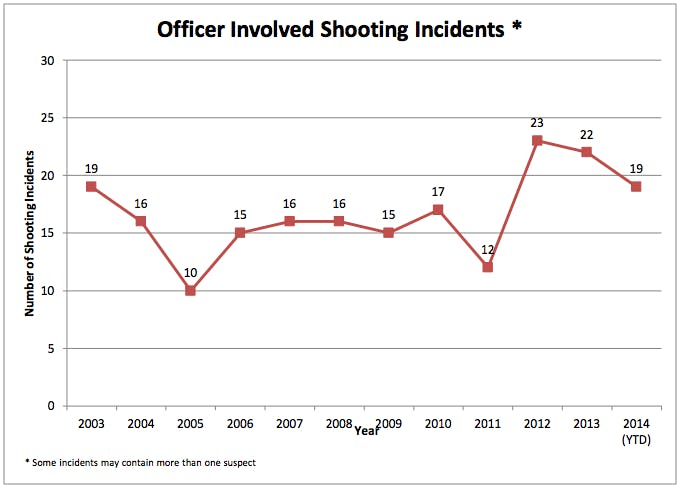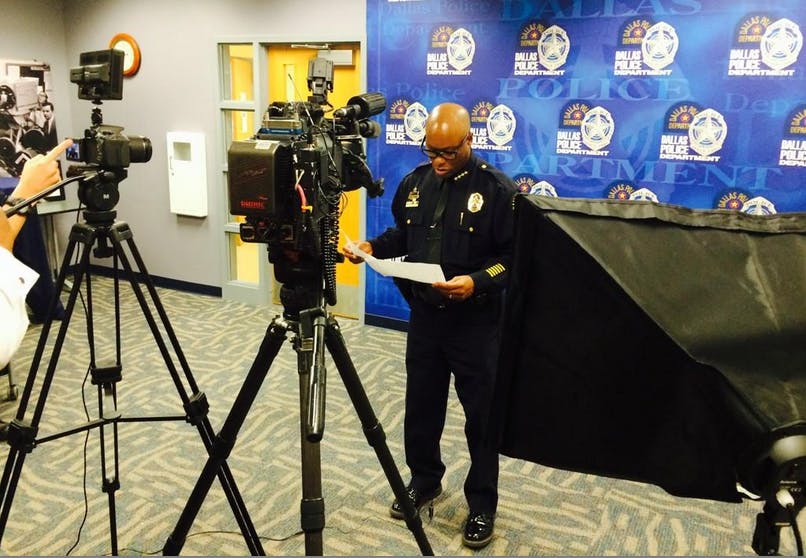The Dallas Police Department is trying to distinguish itself from other local law enforcement agencies by publishing on its website the details of every shooting involving its officers in over a decade.
“Throughout my 32 year career as a Dallas police officer, the citizens of Dallas have shown great trust and confidence in the Dallas Police Department,” Police Chief David Brown said in a statement last week preceding the release of the Officer Involved Shooting (OIS) data. “I understand that this trust is hard to earn, but easy to lose.”
The department said it is releasing the information as part of an effort to provide greater transparency.
“We believe this is an expectation of the community that will increase trust and legitimacy in the OIS investigative process,” said Brown.
Brown wrote that his department plans to post each incident to its website once the investigative process is completed. “We will provide as much information as possible, to include statistical information, a narrative of the incident and the grand jury disposition,” he said.
Currently, there is no reliable national data reflecting how many U.S. citizens are shot by police officers each year, primarily because most local law enforcement agencies are not as forthcoming as the Dallas P.D. with the relevant information.
The nation’s local police departments—of which there are more than 17,000—are asked to self-report officer-involved shootings to the Justice Department. The FBI then compiles an annual report on “justifiable homicides” using the data. Only about 750 law enforcement agencies contribute to DOJ database, however, and the 400 or so annual deaths reported by the FBI is widely considered by experts to be inaccurate.
Less than two weeks after the fatal Aug. 9 shooting of an unarmed black teenager by a Ferguson, Mo., police officer, three top Dallas law enforcement officials gathered with local community members at a downtown Methodist church. Tensions ran high, with residents’ outbursts frequently overpowering Chief Brown’s words.
Brown was present at the gathering to reassure the community that incidents like the one in Missouri were considered a top priority within the department he’d run for over 4 years.
“You can’t have enough oversight when it comes to police officer-involved shootings in any city,” Brown told the crowd, which included the mother of a man killed by local police.
Brown reiterated his support for the county’s Civil Rights Unit, the product of two years of work by Dallas County District Attorney Craig Watkins. Only recently did county commissioners approve funding for two CRU positions: a prosecutor and an investigator.
Watkins told residents that he planned to expand the CRU and have investigators on call 24/7. The unit, he explained, would investigate every officer-involved shooting in the county. “We’re here, we’re listening and we understand your pain,” he said amid outbursts from citizens who questioned the ability of the district attorney’s office to act independently of the Dallas P.D.
Watkins’ unit was formed in the wake of a 2012 shooting of an unarmed man by a Dallas police officer. Rumors that James Harper, 31, had been shot in the back—later refuted by an autopsy report—are said to have nearly caused a riot in the predominantly black South Dallas neighborhood where the incident took place. Area pastors managed to restore calm as officers in riot gear assembled.
It was later revealed that the shooting occurred after a 911 caller reported a bogus kidnapping, and that Harper, whose home was found to contain large quantities of narcotics, had physically attacked an officer, according to police. Nevertheless, it was a pivotal moment, and the Dallas police force recognized that they needed to address the community’s concerns.
Last week, Police Chief Brown specifically recalled Harper’s death in detailing a number of changes he’s implemented since the event. Those changes include notifying the FBI’s civil rights office at the time of an officer-involved shooting; developing a clear foot-pursuit policy; mandating that all officers receive taser training and be required to maintain a certification; and creating a community engagement team, called the Community Affairs Unit, to respond to the public’s concerns.
Following the shooting of 18-year-old Michael Brown by Ferguson Officer Darren Wilson, the Dallas Police Association called upon Chief Brown to equip all of his officers with uniform-worn cameras. Brown noted that, while the project will cost several million dollars, he intends to accept their recommendation and equip more than 1000 officers soon. Approximately 200 of the department’s officers are currently outfitted with cameras.
“Our folks are paying attention to what’s happening out in the rest of the country, and they see the value of wearing a body camera,” Brown told the press earlier this year. “Complaints go down, use of force incidents go down, officers are safer, citizens are safer when you have a camera.”
The statistics now being published on the Dallas P.D.’s website cover incidents as far back as 2003. The page features a map of where officer-involved shootings occurred and it lists whether or not suspects were armed, as well as whether officers killed or wounded them.
Photo via Emily Stanchfield/Flickr (CC BY 2.0) | Remix by Fernando Alfonso III




